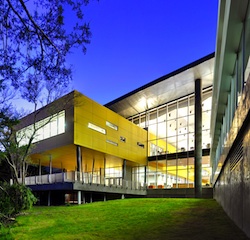Incorporating Flexibility
 By: Jim Luckey, AIA, LEED AP
By: Jim Luckey, AIA, LEED AP
SHW Group Director of Design
Jim is the director of design and a principal at SHW Group. He has practiced architecture for more than 30 years, focusing on educational, corporate, institutional and interactive environments. At SHW Group he is responsible for evolving the firm’s design culture, fostering design at all levels, critiquing projects, mentoring the firm’s design architects, standardizing design processes and establishing design benchmarks.
Much is being discussed and written about the benefits of flexible learning for today’s students — increased relevance, heightened interest, better attendance, improved test scores and better preparation. To educators, it connotes problem-based learning, team-taught subjects and blended learning. However, to administrators, flexibility can imply added complexity in determining staffing ratios and scheduling. It may suggest additional facilities, only partially utilized, that must be maintained. It has dollar signs written all over it. By bringing together educators, administrators and architects, all groups can work together to design a building that meets all stakeholders’ needs. To do so effectively, all involved parties should be engaged prior to beginning the design process, arrive at a common definition of flexible learning, establish performance criteria that support all participants’ needs and plan for a building that is designed and built for flexibility.
Before starting a project, an architect must understand a client’s flexibility goals to incorporate effective strategies into the building design. Within educational environments, that strategy can require a variety of perspectives including educators, facility directors, parents, students, professional consultants and building operators.
Engaging these groups early on through visioning sessions allows an architect to understand all requirements and integrate flexibility in ways that meet the different needs of each group. The process requires an orchestration of all stakeholder needs in order to create a building that works for all parties involved. At Dallas Independent School District’s Gilliam Collegiate Academy, SHW Group conducted an intensive visioning process, involving designers, programmers, administrators, teachers and students to determine how the facility could best meet the needs of teachers and students. Based on the information gathered in these sessions, SHW Group created a unique, flexible design that mirrors a collegiate environment while maintaining the supervision appropriate for high school students.
Once needs and goals are established, it is important to design the building flexibly, such that it can easily adapt and change should stakeholders’ needs evolve over the life of the building. By preemptively anticipating potential future needs and changes in educational approaches and teaching methods, an architect can design a building which will accommodate these future changes that are important to educators. This also appeals to district administrators as this type of foresight can extend the building’s life span, saving expensive construction costs on future renovations.
In addition to both understanding and anticipating stakeholders’ overall needs, it is also important to identify and agree on the end-skills students need to acquire. This allows the architect to understand specifically how the individual spaces will be used instructionally and operationally. By focusing on the common basic needs and shared tools between different subjects, designers can build just one space that teachers and students can use for different functions. This ultimately translates into more generic, flexible learning space that supports common activities, as opposed to a variety of customized spaces for specific subjects. In the end, this generic space achieves a higher percentage of student utilization and allows a building to have less square footage. This smaller building costs less to build and results in lower maintenance and energy costs. In the end, a smaller building equals savings from construction throughout the life of the building. Superintendents, in particular, find this most attractive as the money saved from building a smaller school can be reinvested into upgraded building materials, sustainable features or curriculum.
When SHW Group designed Carl Wunsche Sr. High School, a Career Academy in Spring ISD, flexible space was a huge priority for the school. The school offers students the opportunity to earn college articulated credit and to get a head start on their post-secondary education. During their time there, students participate in workplace learning activities, internships, mentorships, and cooperative learning programs. The school’s unique career tech focus required that their spaces be flexible to adapt and change to the demands of the marketplace. This allows the school’s individual spaces to change as certain subjects become more relevant and in demand than others. SHW Group also designed an open space in the middle of two of the three academies to support evolving technology needs. Everything in the space was intended for easy movement, including walls and furnishings which allow the school to flex the spaces as needed through the life of the building with no additional investment. Power and data were distributed under a raised floor to make the space easily adaptable.
There can be schools which support flexible learning and meet the needs and requirements of all the stakeholders. And will ultimately equal both architectural and educational success.
